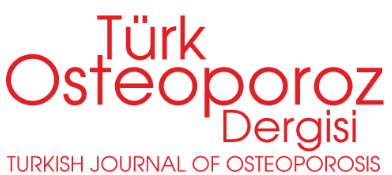Aim: The aim of this study was to compare the efficacy of risendronate and raloxifene treatments on bone mineral density (BMD) and biochemical markers of bone turnover in postmenopausal osteoporosis. Material and Method: Eighty-tree patients were randomly assigned to two groups. Forty-two patients (group=1) were treated with risendronate (35 mg/ week) and 41 patients (group=2) with raloxifene (60 mg/ day) for a period of one year. Additionally, 1200 mg/ daily calcium and 800 IU/ day vitamin D were given to both groups. Bone mineral density (BMD) was measured at lumbar, femur neck and trochanteric regions by dual-energy x-ray (DEXA) at baseline and at the end of the study. Among the markers of bone turnover, osteocalcine (OC), deoxypyridinoline (DPD), and alkaline phosphates (ALP) levels were determined at the beginning, at the end of 6 and 12 months. Additionally, total cholesterol levels were measured. Results: At the end of the treatment, significantly increases in lumbar BMD were seen in both groups (group 1; p 0.001, group; 2 p 0.05). The increases in femur neck and trochanteric regions were significant in only group 1 (p 0.05). In both groups, serum OC (group 1; p 0.01, group 2; p 0.05), DPD (group 1; p 0.001, group 2; p 0.05), and ALP (group 1; p 0.001, group 2; p 0.05) were found to be significantly decreased at 6th and 12th months of the treatment period. There was a significant decrease in the level of cholesterol in 6. and 12. month only in group 2 ( p 0.05). Our results indicated that in postmenopausal women with osteoporosis risendronate treatment increased BMD in lumbar spine, femoral neck and trochanteric region. On the other hand, raloxifene provided an increase only in the lumbar spine BMD. Conclusion: This finding suggested that raloxifene may be an alternative in hypercholesterolemic women who have only spinal osteoporosis. (Osteoporoz Dünyasindan 2006;12:50-4)Key words: Postmenopausal osteoporosis, risendronate, raloxifene
Article in Turkish(Use the link for full-text in Turkish)
Aim: The aim of this study was to compare the efficacy of risendronate and raloxifene treatments on bone mineral density (BMD) and biochemical markers of bone turnover in postmenopausal osteoporosis. Material and Method: Eighty-tree patients were randomly assigned to two groups. Forty-two patients (group=1) were treated with risendronate (35 mg/ week) and 41 patients (group=2) with raloxifene (60 mg/ day) for a period of one year. Additionally, 1200 mg/ daily calcium and 800 IU/ day vitamin D were given to both groups. Bone mineral density (BMD) was measured at lumbar, femur neck and trochanteric regions by dual-energy x-ray (DEXA) at baseline and at the end of the study. Among the markers of bone turnover, osteocalcine (OC), deoxypyridinoline (DPD), and alkaline phosphates (ALP) levels were determined at the beginning, at the end of 6 and 12 months. Additionally, total cholesterol levels were measured. Results: At the end of the treatment, significantly increases in lumbar BMD were seen in both groups (group 1; p 0.001, group; 2 p 0.05). The increases in femur neck and trochanteric regions were significant in only group 1 (p 0.05). In both groups, serum OC (group 1; p 0.01, group 2; p 0.05), DPD (group 1; p 0.001, group 2; p 0.05), and ALP (group 1; p 0.001, group 2; p 0.05) were found to be significantly decreased at 6th and 12th months of the treatment period. There was a significant decrease in the level of cholesterol in 6. and 12. month only in group 2 ( p 0.05). Our results indicated that in postmenopausal women with osteoporosis risendronate treatment increased BMD in lumbar spine, femoral neck and trochanteric region. On the other hand, raloxifene provided an increase only in the lumbar spine BMD. Conclusion: This finding suggested that raloxifene may be an alternative in hypercholesterolemic women who have only spinal osteoporosis. (Osteoporoz Dünyasindan 2006;12:50-4)Key words: Postmenopausal osteoporosis, risendronate, raloxifene
Osteoporoz düsük kemik kütlesi ve kemik dokusunun mikro mimari yapisinin bozulmasi sonucu kemik kirilganliginda ve kiriga yatkinlikta artis ile karakterize sistemik bir iskelet hastaligidir (1). Ortalama yasam süresinin uzamasina bagli olarak yasli nüfusun ve sonuçta osteoporoz prevalansinin artmasi nedeniyle hastalik giderek önem kazanmaktadir (2). Ayrica osteoporoza bagli olusan kiriklar nedeniyle ortaya çikan yüksek tedavi maliyetleri, ekonomik olarak is gücü kayiplarinin büyüklügü ve ölüm oranin artmasi göz önüne alindiginda OP önemli bir halk sagligi sorunudur (3). Bütün bu faktörler, metabolik kemik hastaliklarina özellikle de osteoporoza yönelik medikal çalismalari ön plana çikarmis ve kemik kaybini azaltan ya da hiç olmazsa durduran yeni tedavi seçeneklerini gündeme getirmistir (4).Osteoporoz tedavisinde kemik rezorpsiyonunu engelleyen ilaçlar (kalsiyum, D vitamini, östrojen, selektif östrojen reseptör modülatörleri, kalsitonin, bifosfonatlar) ve kemik formasyonunu artiran ilaçlar (parathormon, anabolik steroidler, sodyum florür, büyüme faktörleri, kalsitriol) kullanilmaktadir. Fakat günümüzde tamamen güvenilir olan, etkili ve genel olarak kabul edilmis bir tedavi henüz tanimlanmamistir (5).Postmenopozal osteoporozlu kadinlarda bu tedavi yöntemlerinden, hem raloksifen (6,7) hem de risedronat (8,9) tedavileri yeni vertebral kiriklari önlemede, KMY yi artirmada ve kemik döngüsünün biyokimyasal belirleyicilerini düsürmede etkilidirler.Selektif östrojen reseptör modülatörleri (SERM) grubu içinde yer alan raloksifen, KMY ve serum lipitlerine olan olumlu etkisi ile postmenopozal osteoporozun önlenmesi ve tedavisinde tercih edilebilecek bir ajan olarak görülmektedir (10). Bifosfonatlar ise osteoklastik aktiviteyi inhibe ederek kemik mineralizasyonunu ve kemik yikimini önlerler ve bu etkilerini kemigin hidroksi apatit kristallerine baglanarak gösterirler (11). Üçüncü kusak bir bifosfonat olan risedronatin klinik etkinligi yapilan çalismalarda gösterilmistir (12,13).Postmenopozal osteoporozlu kadinlarda gerçeklestirdigimiz bu çalismayi, risedronat ve raloksifen tedavilerinin KMY ve kemik döngüsü üzerine olan sonuçlarini karsilastirmak ve bu iki tedavinin OP üzerindeki etkilerini saptamak amaciyla planladik.



